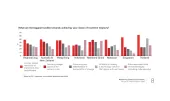Will cash survive beyond the 21st century?
By Mike Lee Whenever I read about the apparently imminent arrival of the cashless society, I smile quietly to myself, knowing that the global facts tell a completely different story, one which should see cash surviving beyond the 21st century.
Take the latest press release from London-based Retail Banking Research, for example: “The total number of ATM cash withdrawals worldwide is expected to increase at an average of 8% per year between 2010 and 2016, compared to an average of 6% per year in the number of [ATM] installations.”[1]
How many countries in today’s economic slow-down would not die for a GDP rate of 6%? And here we have the leading retail banking research institute forecasting a 6% growth rate in ATM installations and an even higher 8% growth rate for cash withdrawals, both figures well above current global economic growth rates.
Euromonitor International (www.euromonitor.com) reported in May that $14.413 trillion in consumer payments was made with cash worldwide in 2010, compared to consumer payment card transaction value, excluding commercial payments, at $9.582 trillion. It is no wonder, given these, and similar figures, that a recent book on the history of money has stated: “Despite the rise of plastic cards and electronic money transfers, cash is still the most important kind of money in the world.”[2]
Why would the most important kind of money, cash, suddenly disappear after 27 centuries of playing such an important role in all human societies? Cash is one of the most successful human technologies of all time and is not going away any time soon. Those who make extravagant forecasts about the demise of cash simply do not understand its resilience as a technology and its resistance to technological substitution. Those organisations which want to “kill cash” remind me of King Canute who believed he could hold back the ocean tide.
It is the popularity of cash which lies behind its success as a technology and this human reliance on cash shows no signs of abating. The May 2011 issue of Currency News, published by Currency Research Ltd, stated that during the last seven years the banknote market has been increasing in volume, with an overall average global rate of growth of about 6% per year.
A visit to the websites of central banks in virtually every country of the world will reveal similar healthy year-on-year growth in banknotes in circulation, in both developing and developed countries.
I firmly believe that the myth of the cashless society is being propagated by card companies with a vested interest in the demise of cash to give them greater market share for cards in payments markets around the world. In addition, the voice of cash is not being sufficiently articulated. Consequently, the ATM Industry Association this year established the ATM Cash Council (www.atmia.com) with a mission to portray the truth about cash by tracking global cash demand, circulation and usage today, whilst protecting the freedom of the world’s citizens to choose to use cash.
Besides, cash is the lifeblood of the ATM industry: “Strong demand for ATM cash withdrawals will remain one of the major drivers of ATM growth in the next few years. RBR expects the global installed base of ATMs to increase by 42% to 3.2 million terminals by 2016.”[3] The US alone manufacturers over 80 million items of cash every working day![4] A total of 62 billion ATM cash withdrawals worldwide in 2009 is forecast to rise to 94 billion cash withdrawals in 2015.[5]
One dimension of cash which is always conveniently overlooked by the anti-cash lobby is its strong socio-political role. A study carried out by the Economic and Social Research Institute warns that the move towards a cashless society would mean that financially excluded households risked becoming increasingly marginalised.[6] Not only is cash used in the huge informal economies of both advanced and emerging countries and among lower income groups as an important budgeting tool, but the demographic group of the elderly depend heavily on this form of money.
[1] “Asia-Pacific ATM market booms while USA and much of Western Europe falls”, RBR press release, 13 October 2011 – www.rbrlondon.com
[2] Money: A History (2nd edition) by the British Museum Press (2007)
[3] “Asia-Pacific ATM market booms while USA and much of Western Europe falls”, RBR press release, 13 October 2011 – www.rbrlondon.com
[4] Namely, 38 million banknotes and 42 million coins a day. Sources: 2007 production data, US Mint (coins) and Bureau of Engraving & Printing (notes). “From 1980 to 2009, U.S. currency in circulation increased an average of 7.0 percent per year from $124.8 billion to $888.3 billion.” Source: ”The state of U.S. coins and currency”
FRB testimony before the Subcommittee on Domestic Monetary Policy and Technology, Committee on Financial Services, U.S. House of Representatives, Washington, D.C. July 20, 2010
https://www.federalreserve.gov/newsevents/testimony/roseman20100720a.htm
[5] Source: “China to become world’s largest ATM market by 2015”, RBR Research press release, October 2010
[6] https://www.rte.ie/news/2011/0308/esri-business.html




















 Advertise
Advertise








